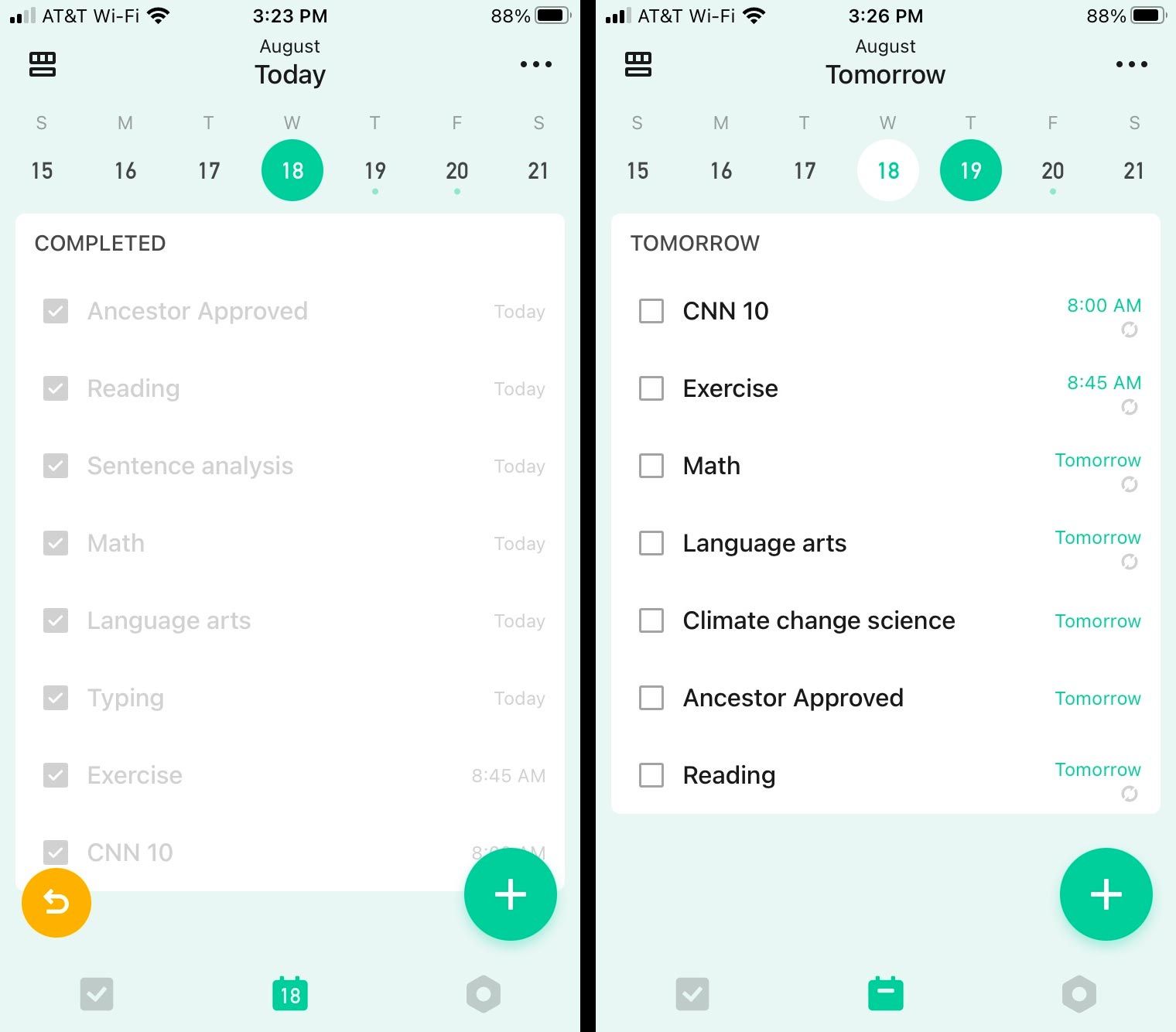Our daily routine
A peek into a day in our homeschooling life: the lessons we cover, and how it all fits together.

I don't think of what we have as a schedule, but rather a predictable rhythm. Having a sense of what to expect from each day, while also knowing that we have the flexibility to shape each day into what feels best right then, seems to be what works best for us.
As I mentioned in my post about lesson planning, I'm ready for my picture of the day to be drastically redrawn into something entirely unexpected if Wanda's interest is piqued. Sometimes it's an idea for a story she wants to write, or a big scientific question she has. Those sparks of inspiration are gold, and I'm happy to push some or even all of this routine aside to let that learning happen. I'm not worried about her "falling behind."
Through the day, I'm using two apps on my phone:
- Seesaw, which is where I record what we're doing, and tag each update with the subject covered. Wanda's dad and grandmas have access, and like seeing what we're up to, it helps everyone feel connected.
- Tick Tick, a calendar-based to-do app that I look at to see what lessons we'll do that day. I've set up this list during my lesson planning. Tick Tick lets me create recurring items, so I don't have to add things like "math" or "exercise" every day, they're automatically there.

7:00 am - Wake-up time
I gently let Wanda know that it's wake-up time, make myself some coffee and fix her breakfast, and settle in at the dining room table. This is when I might do some last-minute lesson planning and review our schedule in Tick Tick.
7:30 am or so - Breakfast
By around 7:30, Wanda has made her way to join me at the dining room table, where we start by watching CNN 10, and sometimes follow that with some It's Okay to Be Smart. We then move to the couch and snuggle up to read something together, this week it's been the fourth Percy Jackson book.
Seesaw: link to CNN 10 [civics, geography & cultures, science], link to It's Okay to Be Smart [science], picture of the book we read [reading]
Tick Tick: check off CNN 10
8:30 am or so - Get dressed, brush teeth
Around 9:00 am - Ring bell
Our official day starts when I ring our school bell. It has a cheery sound that we love. I say, "Good morning, Quercus Prep!" and Wanda runs over and we have a warm hug. I then verbally tell her a rough idea of what's in our day: the lessons I have planned for us and the order we'll do them in, any special things we'll be doing. She weighs in with her thoughts and opinions, and we settle on our plan for the day. If it's Monday, we spend some time at the whiteboard to write a list of things she's interested in learning and doing over the week.
Seesaw: on Monday, add a picture of the Want to Learn list
Tick Tick: check off Want to Learn
Around 9:15 am - Exercise
I ask Wanda what she wants to do for a little exercise. Common choices are Cosmic Kids Yoga, GoNoodle, doing belly flops from our trampoline onto our giant crash pillow, or going in the backyard and jumping rope.
Seesaw: link to video we watched, or a picture or note about the activity [PE]
Tick Tick: check off exercise
Around 9:45 am - Math
Monday-Thursday we do Beast Academy, Fridays we do an activity from Mindset Mathematics. For Beast Academy, we do problems until we feel done, which sounds a bit absurd, but it works. It varies a lot from day to day, but generally it takes about 45 minutes.
Seesaw: add pictures of the pages of the Beast Academy practice book she completed (or pictures of our Mindset Mathematics activity) [math, growth mindset]
Tick Tick: check off math
Around 10:30 am - Break
Wanda takes a break for about 10-15 minutes (usually petting the cats), while I prepare for the next lesson.
Around 10:45 am - Language arts
There are several different ways we learn about language arts, and I try to rotate through them. I often won't choose exactly what we'll do for language arts until I get a feel for how she's doing that day, or think about what other things I want to fit in our day. I might opt for something fast & simple vs. introducing a tricky new concept or expecting a lot of writing. Right now the options tend to be: spelling analysis, Michael Clay Thompson vocabulary, The Writing Revolution activities, Michael Clay Thompson poetics, freewriting, or sometimes I've simply identified a language arts concept we haven't covered and I'll do a freestyle discussion at the whiteboard. The lesson usually will last about 30 minutes.
Seesaw for spelling analysis: add a picture of the complete spelling analysis sheet [language arts]
Seesaw for MCT: add picture of the reading we did, and any related activities she did [language arts, reading]
Seesaw for freewriting: add a note that says she did freewriting (she reads them aloud to me, but prefers to keep the product off Seesaw) [language arts]
Seesaw for TWR: add picture of the TWR activity she completed [language arts, plus whatever subjects the activity related to, usually history or science]
Tick Tick: check off language arts
Around 11:15 am on Monday, Wednesday, or Friday - Sentence analysis
Wanda analyzes one sentence from the practices sentences book of our Michael Clay Thompson curriculum. It takes her about 3 minutes, and then we take another 3 to review it and talk about it together.
Seesaw: add a picture of the completed sentence analysis [language arts]
Tick Tick: check off sentence analysis
Around 11:15 am - Squishy slot
This slot is squishy, see below for what happens with squishy slots.
Around 11:50 am - Lunch prep
This is when I make a lunch for myself. Wanda's lunch was packed by her awesome dad in the morning while we ate breakfast.
Noon - Lunch
We move downstairs, where we have a home theater setup. We watch an educational show, followed by a more fun show, while eating our lunch. This week, we've been watching a show called Rogue Trip on Disney +, with a father/son team visiting countries that we usually only hear about in the context of troubling news stories, places like Colombia, Pakistan, and Lebanon. We've followed up each episode by watching a video from the Geography Now! YouTube channel for the country. Then we've watched an episode of a ridiculous show called Centaurworld.
Seesaw: add a picture of the educational show we watched [usually geography & cultures, or science, or history]
2:30 pm - Exercise with Dad
Wanda and dad jump on the bed and run around like crazy for about 25 minutes every afternoon at 2:30 pm.
Squishy slots
Between the time right before lunch, the time between lunch and exercise time, and after exercise time, I'm often able to fit in one or two other lessons. These roughly rotate between things like typing lessons, history, science experiments, field trips, reading, and as much as possible they focus on what Wanda wants to be learning and doing. It's where I'll fit in special activities, like filling out a voting ballot together, or baking muffins.
Seesaw: pictures of what we're doing, unless it's something totally Wanda-driven, in which case she usually opts to not add it to Seesaw [science, history, geography & cultures, life skills, making, civics, arts, research, reading...]
Tick Tick: check off the activities
The day gradually and naturally shifts from being lesson-focused to being totally Wanda-focused. We used to ring the bell at the "end" of the day, but that started to feel weird—learning keeps happening, and it didn't feel natural to cap the day. There's no discrete "end" to our day.
Late afternoon
By this time, Wanda's doing her own thing—crafting something, writing a story, reading a book, drawing or painting, playing Prodigy—and I'm able to do lesson planning, or put away a delivery of groceries. This is also when play dates are most likely to happen.
End of the day
By the end of the day, I have a list of completed items in Tick Tick (or moved to some day in the future), and I have a whole mess o' pics of what we've done in the day in Seesaw. I've found that tagging the subjects we've covered in Seesaw helps me see all the places where we're learning even if it didn't fall within a planned lesson; it helps crystallize that she is doing a lot of learning every day.
This is the routine that works for us, for now. Another homeschooling family's day would look quite different—even entirely different—because every family has unique desires, needs, styles, and constraints.

